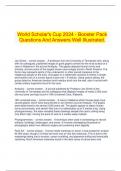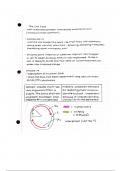World Scholar's Cup 2024 - Booster Pack
Questions And Answers Well Illustrated.
Jan Simek - correct answer. A professor from the University of Tennessee who, along
with his colleagues, published images of giant glyphs carved into the mud surface of a
cave in Alabama in the journal Antiquity. The glyphs depicted human forms and
animals, and are some of the largest known cave images found in North America. The
forms may represent spirits of the underworld, or other sacred creatures to the
indigenous people of the area. One glyph of a rattlesnake reaches 3 metres in length,
and another one of a human figure is just over 1.8 metres. Using carbon dating, the
group dated an American bamboo torch residue stuck into the wall, also in accord with
certain pottery fragments found in the cave.
Antiquity - correct answer. A journal published by Professor Jan Simek of the
University of Tennessee and his colleagues that displays images of nearly 2,000-year-
old mud cave carvings found in 19th Unnamed Cave, Alabama.
19th unnamed cave - correct answer. A cave in Alabama which houses large cave
carved glyphs, which were documented in Jan Simek's journal Antiquity. The glyphs
were determined to be almost 2,000 years old. The glyphs appear to depict human
forms and animals, and stretch (like one of a rattlesnake) up to 3 metres long. Using
photogrammetry, the team revealed these drawings despite the cave's ceiling being
only 60cm high, moving the point of view to 4 meters away instead.
Photogrammetry - correct answer. A technique often used in archaeology to record
artifacts, buildings, landscapes, and caves. It involves overlapping thousands of
photographs taken from different angles and combining them digitally.
Rock Art - correct answer. Human made markings on stone. It has existed for at least
64,000 years, though it is likely we know only of very few instances. This is due to thin
engravings being lost to erosion, caves crumbling, and pigments dulling and eventually
vanishing. North American instances found in the dark zones of caves were only
,discovered in 1979, more than a century after its discovery in Europe, found in Northern
Spain.
Maltravieso - correct answer. A cave in Estremadura, Spain that houses many
drawings that were difficult to date by Paul Pettitt, Alistair Pike, and their team. 70 years
after the cave was originally found and studied, they digitally found a hand stencil drawn
onto the rocky surface of the cave, which was obscured by built up calcium carbonate
deposits.
Light engraving - correct answer. A cave painting technique commonly used during
the Pleistocene era, in which the image is only visible when light is shone at a certain
oblique angle (the light is often referred to as raking light). It makes finding cave
drawings notoriously difficult for researchers.
Reflectance Transformation Imaging (RTI) - correct answer. A technique similar to
photogrammetry in which 3d models can be illuminated from any angle, which makes it
much easier to detect cave drawings, specifically ones using the technique of light
engraving.
Pulsed terahertz imaging - correct answer. A very recently found technology that uses
infra-red waves to penetrate through layers of prehistoric wall plaster to reveal possible
cave paintings underneath, a technique developed from full body scanners in airport
security systems, which are used to see concealed weapons or contraband. This
technique was first used in Çatalhöyük, Turkey in 2011.
Lascaux Cave - correct answer. A cave in France that display over 600 cave paintings
and a thousand engravings. It was discovered in 1940 when a group of four teenagers
were trying to rescue their dog that fell down a hole, crawling into the cave revealed
hundreds of prehistoric animals painted across its walls and ceiling. It became an
extremely popular tourist attraction after WWII, but public access to the cave became
closed in 1963 because the breath and sweat of visitors created carbon dioxide and
humidity that would damage the paintings. It has no stalactites or stalagmites because
there is a layer of clay in the soil that waterproofs the cave, preserving the hundreds of
paintings and engravings within. It is believed that the many bulls and horses depicted
in the engravings and paintings are not to show what was eaten by those humans,
which would have consisted of mammoths or reindeer, but to show what their spiritual
beliefs were. Something unknown about the paintings is how long it took to complete,
though
Lascaux IV - correct answer. A replica created in 2017 when the French government
spent $64 million dollars building a near perfect replica to recreate the original Lascaux
cave, which was not open to tourists due to the damage it causes to the paintings. It is
very precise due to the 3d digital scanning of the actual cave, and made with
polysterine, resin, and fibreglass. The replica tries to recreate the original as best as
possible, including playing sounds of the surrounding forest played on speakers. It
involves the traveller to go from outside to inside and back to outside. The replica also
, features the hole that the boys fell down, something that was blocked off in the original
due to over heating from tourists. It has interactive tablets in its exhibits to give visitors
more information about the many displays.
Dina Casson - correct answer. A member of the team that worked on the Lascaux IV's
design.
Sequencing (of a museum) - correct answer. The order that a visitor of a museum
travels through its displays. It is very important to designers who want to create an
authentic experience in open-air museums.
Jean-Pierre Chadelle - correct answer. An archaeologist who commends the
advanced techniques used by early humans to create the many engravings and
paintings in the Lascaux Cave. He used to give tours to the original cave.
Guillaume Colombo - correct answer. Director of the museum complex at Lascaux.
The Hall of Bulls - correct answer. The first big room of the replica of the Lascaux
cave.
Thorsen Kjetilis - correct answer. One of the architects of the Lascaux IV museum,
which he believes is a link between the past and present, being a contemporary building
cut into the landscape and out of the landscape.
Francis Ringenbach - correct answer. Led the team of 34 artists to copied the
paintings of the original Lascaux cave onto the replica in the Lascaux IV museum
complex. He tells that often the animals depicted were placed intentionally in a part
which was easier to carve, such as replacing the eye of a bison with a natural cavity
instead of carving it.
Mono-ha - correct answer. A Japanese art group that is known for juxtaposing natural
and industrial materials. It literally translates to "the School of Things". The group
gained more recognition following its emergence in the late 1960s. Despite never
forming a formal association, artists of this movement were joined by a shared
commitment to a refusal of "making", or what Lee Ufan explains as a desire to present
the world as it is, without undue interference on the part of the artist or from the viewers'
expectations concerning the artist's capacity for creation.
Mika Yoshitake - correct answer. Assistant curator at the Hirschhorn Museum and
Sculpture Garden in Washington DC, he organized the Requiem for the Sun
Requiem for the Sun - correct answer. An exhibition in 2012 organized by Mika
Yoshitake that is the first substantial offering of Mono-ha works in the US, and housed a
sample of some of the group's most celebrated works, including Phase-Mother Earth by
Nobuo Sekine. It was installed in a manner that is best described as conscientious,
though it notably lacked the tension between spontaneity and control, which was a





